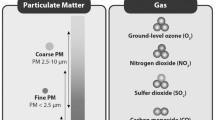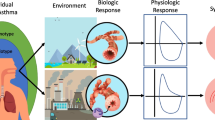Abstract
Air pollution exposure is associated with increased asthma and allergy morbidity and is a suspected contributor to the increasing prevalence of allergic conditions. Observational studies continue to strengthen the association between air pollution and allergic respiratory disease, whereas recent mechanistic studies have defined the prominent role of oxidative stress in the proallergic immunologic effects of particulate and gaseous pollutants. The identification of common genetic polymorphisms in key cytoprotective responses to oxidative stress has highlighted the importance of individual host susceptibility to pollutant-induced inflammation. Future therapy to reduce the adverse effects of air pollution on allergic respiratory disease will likely depend on targeting susceptible populations for treatment that reduces oxidative stress, potentially through enhancement of phase 2 enzymes or other antioxidant defenses.
Similar content being viewed by others
References and Recommended Reading
Eder W, Ege MJ, von Mutius E: The asthma epidemic. N Engl J Med 2006, 355:2226–2235.
Li N, Hao M, Phalen RF, et al.: Particulate air pollutants and asthma: a paradigm for the role of oxidative stress in PM-induced adverse health effects. Clin Immunol 2003, 109:250–265.
World Health Organization: Meta-analysis of time-series studies and panel studies of particulate matter (PM) and ozone (O3). Available at: http://www.euro.who.int/document/e82792.pdf. Accessed December 26, 2007.
Gauderman WJ, Avol E, Gilliland F, et al.: The effect of air pollution on lung development from 10 to 18 years of age. N Engl J Med 2004, 351:1057–1067.
Abbey DE, Burchette RJ, Knutsen SF, et al.: Long-term particulate and other air pollutants and lung function in nonsmokers. Am J Respir Crit Care Med 1998, 158:289–298.
Watts J: Doctors blame air pollution for China’s asthma increases. Lancet 2006, 368:719–720.
World Health Organization: Health aspects of air pollution with particulate matter, ozone and nitrogen dioxide. Report on a WHO Working Group: Bonn: World Health Organization 2003. Available at: http://www.euro.who.int/document/e79097.pdf. Accessed November 2, 2007.
McConnell R, Berhane K, Yao L, et al.: Traffic, susceptibility, and childhood asthma. Environ Health Perspect 2006, 114:766–772.
Wilson SR, Yamada EG, Sudhakar R, et al.: A controlled trial of an environmental tobacco smoke reduction intervention in low-income children with asthma. Chest 2001, 120:1709–1722.
Janssen NAH, Brunekreef B, Van Vliet P, et al.: The relationship between air pollution from heavy traffic and allergic sensitization, bronchial hyperresponsiveness, and respiratory symptoms in Dutch schoolchildren. Environ Health Perspect 2003, 111:1512–1518.
Gergen PJ, Turkeltaub PC, Kovar MG: The prevalence of allergic skin test reactivity for common aeroallergens in the US population: results from the second National Health and Nutrition Examination Survey. J Allergy Clin Immunol 1987, 80:669–679.
Pénard-Morand C, Charpin D, Raherison C, et al.: Long-term exposure to background air pollution related to respiratory and allergic health in schoolchildren. Clin Exp Allergy 2005, 35:1279–1287.
Devouassoux G, Saxon A, Metcalfe DD, et al.: Chemical constituents of diesel exhaust particles induce IL-4 production and histamine release by human basophils. J Allergy Clin Immunol 2002, 109:847–853.
Salvi S, Blomberg A, Rudell B, et al.: Acute inflammatory responses in the airways and peripheral blood after short-term exposure to diesel exhaust in healthy human volunteers. Am J Respir Crit Care Med 1999, 159:702–709.
Nordenhall C, Pourazar J, Ledin MC, et al.: Diesel exhaust enhances airway responsiveness in asthmatic subjects. Eur Respir J 2001, 17:909–915.
Takenaka H, Zhang K, Diaz-Sanchez D, et al.: Enhanced human IgE production results from exposure to the aromatic hydrocarbons from diesel exhaust: direct effects on B-cell IgE production. J Allergy Clin Immunol 1995, 95:103–115.
Fahy O, Hammad H, Senechal S, et al.: Synergistic effect of diesel organic extracts and allergen Der p 1 on the release of chemokines by peripheral blood mononuclear cells from allergic subjects: involvement of the map kinase pathway. Am J Respir Cell Mol Biol 2000, 23:247–254.
Bayram H, Devalia JL, Khair OA, et al.: Comparison of ciliary activity and inflammatory mediator release from bronchial epithelial cells of nonatopic nonasthmatic subjects and atopic asthmatic patients and the effect of diesel exhaust particles in vitro. J Allergy Clin Immunol 1998, 102:771–782.
Nel AE, Diaz-Sanchez D, Ng D, et al.: Enhancement of allergic inflammation by the interaction between diesel exhaust particles and the immune system. J Allergy Clin Immunol 1998, 102:539–554.
Diaz-Sanchez D, Tsien A, Fleming J, et al.: Combined diesel exhaust particulate and ragweed allergen challenge markedly enhances human in vivo nasal ragweed-specific IgE and skews cytokine production to a T helper cell 2-type pattern. J Immunol 1997, 158:2406–2413.
Diaz-Sanchez D, Penichet-Garcia M, Saxon A: Diesel exhaust particles directly induce activated mast cells to degranulate and increase histamine levels and symptom severity. J Allergy Clin Immunol 2000, 106:1140–1146.
Vagaggini B, Taccola M, Cianchetti S, et al.: Ozone exposure increases eosinophilic airway response induced by previous allergen challenge. Am J Respir Crit Care Med 2002, 166:1073–1077.
Diaz-Sanchez D, Garcia MP, Wang M, et al.: Nasal challenge with diesel exhaust particles can induce sensitization to a neoallergen in the human mucosa. J Allergy Clin Immunol 1999, 104:1183–1188.
Arbes SJ Jr, Gergen PJ, Elliott L, et al.: Prevalences of positive skin test responses to 10 common allergens in the US population: results from the third National Health and Nutrition Examination Survey. J Allergy Clin Immunol 2005, 116:377–383.
American Lung Association: State of the Air 2005. Available at: www.lungusa2.org/embargo/sota05/SOTA05_final.pdf. Accessed November 2, 2007.
Ziska LH, Gebhard DE, Frenz DA, et al.: Cities as harbingers of climate change: common ragweed, urbanization, and public health. J Allergy Clin Immunol 2003, 111:290–295.
Bowler RP, Crapo JD: Oxidative stress in allergic respiratory disease. J Allergy Clin Immunol 2002, 110:349–356.
Li N, Wang M, Oberley TD, et al.: Comparison of the pro-oxidative and proinflammatory effects of organic diesel exhaust particle chemicals in bronchial epithelial cells and macrophages. J Immunol 2002, 169:4531–4541.
Gurgueira SA, Lawrence J, Coull B, et al.: Rapid increases in the steady-state concentration of reactive oxygen species in the lungs and heart after particulate air pollution inhalation. Environ Health Perspect 2002, 110:749–755.
Nightingale JA, Maggs R, Cullinan P, et al.: Airway inflammation after controlled exposure to diesel exhaust particulates. Am J Respir Crit Care Med 2000, 162:161–166.
Ng D, Kokot N, Hiura T, et al.: Macrophage activation by polycyclic aromatic hydrocarbons: evidence for the involvement of stress-activated protein kinases, activator protein-1, and antioxidant response elements. J Immunol 1998, 161:942–951.
Hashimoto S, Gon Y, Takeshita I, et al.: Diesel exhaust particles activate p38 MAP kinase to produce interleukin 8 and RANTES by human bronchial epithelial cells and N-acetylcysteine attenuates p38 MAP kinase activation. Am J Respir Crit Care Med 2000, 161:280–285.
Pacheco KA, Tarkowski M, Sterritt C, et al.: The influence of diesel exhaust particles on mononuclear phagocytic cell-derived cytokines: IL-10, TGF-beta and IL-1 beta. Clin Exp Immunol 2001, 126:374–383.
Chan RC, Wang M, Li N, et al.: Pro-oxidative diesel exhaust particle chemicals inhibit LPS-induced dendritic cell responses involved in T-helper differentiation. J Allergy Clin Immunol 2006, 118:455–465.
Kim HJ, Barajas B, Chan RC, Nel AE: Glutathione depletion inhibits dendritic cell maturation and delayed-type hypersensitivity: implications for systemic disease and immunosenescence. J Allergy Clin Immunol 2007, 119:1225–1233.
Gilliland FD, Li YF, Saxon A, et al.: Effect of glutathione-S-transferase M1 and P1 genotypes on xenobiotic enhancement of allergic responses: randomised, placebocontrolled crossover study. Lancet 2004, 363:119–125.
Kamada F, Mashimo Y, Inoue H, et al.: The GSTP1 gene is a susceptibility gene for childhood asthma and the GSTM1 gene is a modifier of the GSTP1 gene. Int Arch Allergy Immunol 2007, 144:275–286.
Romieu I, Ramirez-Aguilar M, Sienra-Monge JJ, et al.: GSTM1 and GSTP1 and respiratory health in asthmatic children exposed to ozone. Eur Respir J 2006, 28:953–959.
Gilliland FD, Li YF, Gong H Jr, Diaz-Sanchez D: Glutathione s-transferases M1 and P1 prevent aggravation of allergic responses by secondhand smoke. Am J Respir Crit Care Med 2006, 174:1335–1341.
Choudhry S, Avila PC, Nazario S, et al.: CD14 tobacco gene-environment interaction modifies asthma severity and immunoglobulin E levels in Latinos with asthma. Am J Respir Crit Care Med 2005, 172:173–182.
Li YF, Gauderman WJ, Avol E, et al.: Associations of tumor necrosis factor G-308A with childhood asthma and wheezing. Am J Respir Crit Care Med 2006, 173:970–976.
Alzoghaibi MA, Bahammam AS: Lipid peroxides in stable asthmatics receiving inhaled steroids and long-acting beta2-agonists. Respirology 2007, 12:439–442.
Vagaggini B, Taccola M, Conti I, et al.: Budesonide reduces neutrophilic but not functional airway response to ozone in mild asthmatics. Am J Respir Crit Care Med 2001, 164:2172–2176.
Davies RJ, Rusznak C, Calderón MA, et al.: Allergen-irritant interaction and the role of corticosteroids. Allergy 1997, 52(38 Suppl):59–65.
Diaz-Sanchez D, Tsien A, Fleming J, et al.: Effect of topical fluticasone propionate on the mucosal allergic response induced by ragweed allergen and diesel exhaust particle challenge. Clin Immunol 1999, 90:313–322.
Romieu I, Sienra-Monge JJ, Ramirez-Aguilar M, et al.: Genetic polymorphism of GSTM1 and antioxidant supplementation influence lung function in relation to ozone exposure in asthmatic children in Mexico City. Thorax 2004, 59:8–10.
Wan J, Diaz-Sanchez D: Phase II enzymes induction blocks the enhanced IgE production in B cells by diesel exhaust particles. J Immunol 2006, 177:3477–3483.
Ritz SA, Wan J, Diaz-Sanchez D: Sulforaphane-stimulated phase II enzyme induction inhibits cytokine production by airway epithelial cells stimulated with diesel extract. Am J Physiol Lung Cell Mol Physiol 2007, 292:L33–L39.
Kruzel ML, Bacsi A, Choudhury B, et al.: Lactoferrin decreases pollen antigen-induced allergic airway inflammation in a murine model of asthma. Immunology 2006, 119:159–166.
Ryan JJ, Bateman HR, Stover A, et al.: Fullerene nanomaterials inhibit the allergic response. J Immunol 2007, 179:665–672.
Author information
Authors and Affiliations
Corresponding author
Rights and permissions
About this article
Cite this article
Riedl, M.A. The effect of air pollution on asthma and allergy. Curr Allergy Asthma Rep 8, 139–146 (2008). https://doi.org/10.1007/s11882-008-0024-8
Published:
Issue Date:
DOI: https://doi.org/10.1007/s11882-008-0024-8




